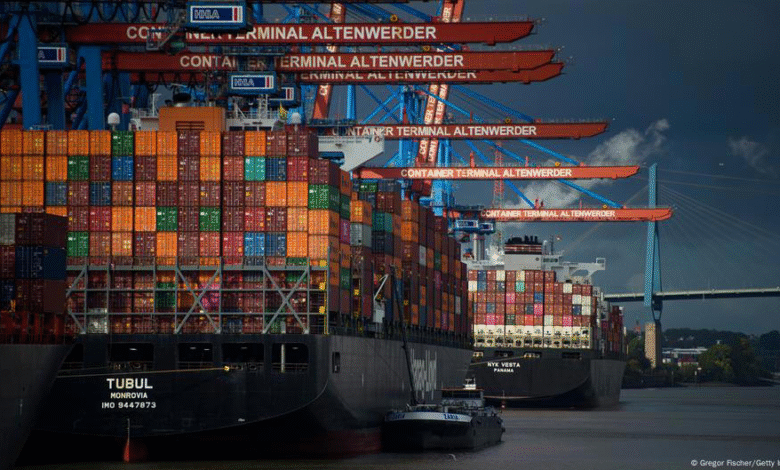EU Countermeasures: Trump Doubles Steel Tariffs to 50%

In response to President Trump’s decision to double steel tariffs to 50%, the EU is taking a firm stance by preparing to impose countermeasures steel tariffs of its own. This escalation not only intensifies the ongoing trade conflict between the EU and the US, but it also adds to the growing uncertainty in the global economy. The increase in steel import duties is expected to have far-reaching implications for manufacturers on both sides of the Atlantic, as they struggle with rising costs and potential retaliatory measures. The EU’s commitment to respond with tariffs demonstrates its willingness to protect its interests while advocating for a negotiated resolution to this escalating trade tension. If an agreement isn’t reached by the stipulated deadline, these countermeasures will inevitably take effect, further complicating an already strained international trade landscape.
The European Union is actively gearing up to implement counteracting measures following President Trump’s recent hike in steel import tariffs. This development comes as the EU seeks to navigate through the complexities of trade relations, particularly in light of the rising tensions that have characterized the trade conflict between Europe and the United States. By anticipating the implementation of steel duties in retaliation, the EU aims to safeguard its economic interests while addressing the implications of the increased tariffs initiated by the US. The looming question is how these responses will shape the broader landscape of international trade, especially amidst concerns of global economic instability. Ultimately, the EU’s strategy underscores its commitment to maintaining fair trade practices while defending its market from unilateral tariffs imposed by foreign nations.
The Impact of Trump Steel Tariffs on Global Trade
President Trump’s recent decision to double steel tariffs from 25% to 50% has sent shockwaves through the global trade landscape. This escalation in tariff rates not only affects steel producers in the United States but also reverberates across international markets. Countries reliant on steel exports to the U.S. are now facing potential declines in their economic stability, which could result in significant job losses and price increases for consumers. The newly imposed import duties further complicate the dynamics of global trade, especially in a time marked by uncertainties in the global economy.
As nations around the world respond to these aggressive tariff measures, the potential for a trade conflict between the U.S. and other economies, particularly within the European Union, becomes increasingly likely. With the EU’s assertion that they are prepared to impose countermeasures, the underlying tensions in the trade relationship between the EU and the U.S. may escalate. Stakeholders in the steel market, as well as consumers, must brace for fluctuating prices and potentially fewer choices as the trade dynamics shift.
EU Countermeasures Against U.S. Steel Tariffs
In reaction to President Trump’s decision to raise steel tariffs, the European Union has firmly stated its readiness to impose countermeasures. As the EU has expressed, the tariffs threaten to destabilize international markets and undermine collaborative efforts to reach negotiated solutions. The planned countermeasures are seen as necessary to protect European steel producers who are now at a competitive disadvantage given the heightened U.S. import duties.
The EU has indicated that if a mutually acceptable solution is not found, both existing and additional measures could be activated as early as July 14. This looming deadline reflects the growing urgency within the EU to safeguard its trade interests amid increasing tensions. The countermeasures could target various U.S. products, potentially escalating a trade conflict that would have wide-reaching implications for the economies involved and the global economic landscape as a whole.
The Potential Consequences of Increased Steel Import Duties
The decision to increase steel import duties by President Trump is poised to have far-reaching consequences not only for the steel industry but also for the overall U.S. economy. Higher tariffs typically lead to increased prices for steel, which, in turn, could raise production costs for various industries reliant on steel as a raw material. This rise in costs could then be passed down to consumers, leading to inflationary pressures across multiple sectors.
Moreover, the retaliation from the EU, alongside reactions from other countries, could trigger a ripple effect through the global economy. The potential for cascading tariffs can lead to a situation where retaliatory measures result in decreased trade flows and economic growth. As companies reassess their supply chains to avoid higher costs, the possibility of job losses and increased prices for consumers becomes imminent. This cycle of retaliatory tariffs could ultimately harm the very industries the U.S. aims to protect.
Trade Conflict Between the EU and the U.S.: Rising Tensions
The escalation of trade tensions between the U.S. and the EU highlights the fragility of international trade relationships. The doubling of steel tariffs by the U.S. serves as a critical flashpoint in this ongoing trade conflict. The EU, long viewed as a crucial ally for the U.S., finds itself challenged to respond robustly without exacerbating the situation further. Their countermeasure strategy showcases a necessity for balance: protecting domestic industry while attempting to negotiate peace in trade relations.
The ongoing trade conflict raises important questions about the future of global economic cooperation. With both sides employing aggressive tactics, the risk of a full-blown trade war increases. This conflict may not only affect steel trade, but also extend into other sectors, revealing the interconnectedness of international markets. Businesses and consumers alike are left to navigate this uncertainty, with the stakes growing more consequential by the day.
Understanding the Role of Tariffs in International Trade
Tariffs play a crucial role in shaping international trade policies and economic outcomes. They serve as tools for governments to protect domestic industries from foreign competition but can also lead to greater economic isolation. President Trump’s decision to implement higher steel import duties reflects an inclination to prioritize American manufacturing at the risk of inciting retaliatory measures from trading partners. The impact of such tariffs serves as a reminder of the complex web of relationships in global commerce.
As countries like the EU prepare countermeasures in response to U.S. tariffs, the implications for international trade become more pronounced. Tariffs can disrupt supply chains, inflate costs for consumers, and hinder global economic growth. The strategic use of tariffs thus presents a double-edged sword, which, while intended to protect local economies, can result in broader economic fallout and escalated tensions among nations.
The Future of Steel Trade in a Tariff-Heavy Landscape
As countries grapple with the impacts of increased tariffs, the future of global steel trade remains uncertain. With the U.S. doubling its steel import duties, global steel producers must adapt quickly to a dramatically altered landscape. The EU’s potential countermeasures, alongside responses from other nations, suggest that the competitive dynamics of the steel market will significantly shift, which could lead to new players emerging and others faltering.
Moreover, the evolving landscape underscores the necessity for open dialogue and negotiations to seek amicable solutions that avoid full-scale trade wars. Stakeholders in the steel industry must engage in strategic planning to mitigate the immediate impacts of tariffs while also advocating for sustainable trade practices that foster growth rather than conflict. The resilience of global trade systems will depend heavily on the ability of nations to collaborate in addressing tariff-related challenges.
Analyzing Economic Uncertainties in the Wake of Tariff Changes
The recent announcement by President Trump to raise steel tariffs has intensified existing economic uncertainties, not just in the U.S. but worldwide. Economies heavily reliant on trade are experiencing heightened volatility as businesses and consumers struggle to comprehend the long-term implications of such decisions. As costs rise and market access becomes more complicated, economic projections may suffer, potentially leading to slower growth rates.
Consumers could face increased prices on everyday goods as manufacturers adjust to the new costs brought about by higher steel prices. Furthermore, the specter of additional tariffs looms over various sectors, leading to an environment of insecurity where investment decisions are delayed or reconsidered. This economic uncertainty may stunt innovation and slow down progress, demonstrating the profound effects of trade policies on the broader economic environment.
The Reaction of Global Markets to Tariff Increases
Global markets have historically reacted with fluctuation to news about tariff increases, and the recent actions taken by President Trump are no exception. Financial markets are likely to experience increased volatility as investors reassess the risk associated with U.S. companies that depend on steel for their production. Stocks in industries tied to steel manufacturing could see significant dips, while those in sectors that may benefit from reduced competition might rise.
Investor sentiment could be further exacerbated as uncertainty permeates trading strategies, leading to a potential decline in market confidence. The reaction of global markets underscores the interconnected nature of international economies and how shifts in policy from one nation can trigger widespread repercussions across the globe. As stakeholders closely monitor these changes, the ability to navigate market fluctuations effectively will be key to mitigating losses.
Navigating Trade Relations Amidst Tariff Challenges
Navigating trade relations in the context of increased tariffs presents complex challenges for nations. The character of trade has shifted significantly, with countries now forced to reassess their strategies and alliances in light of President Trump’s steel tariffs. The EU’s decision to prepare countermeasures is indicative of the shifting landscape where traditional diplomacy may give way to more hostile exchanges.
In the face of these challenges, it is essential for nations to engage in robust dialogue and foster negotiations aimed at diffusing tensions. Establishing frameworks for cooperation can lead to mutually beneficial outcomes, ultimately improving trade relations. Moving forward, stakeholders must prioritize communication and collaboration to ensure sustainable trade practices that benefit economies while minimizing conflict.
Frequently Asked Questions
What are the potential impacts of EU countermeasures steel tariffs in response to Trump’s steel tariffs?
The EU countermeasures steel tariffs, in response to Trump’s doubling of steel tariffs to 50%, could significantly impact trade relations between the EU and the US. These tariffs may escalate the ongoing trade conflict, resulting in increased costs for consumers and businesses in both regions, potentially leading to higher prices and disruption in supply chains. Furthermore, they contribute to global economy uncertainty, impacting international markets.
How does the EU plan to implement countermeasures to Trump’s steel import duties?
The EU plans to implement countermeasures to Trump’s steel import duties by reinstating previously paused tariffs and potentially adding new measures effective from 14 July or earlier if necessary. This strategy aims to balance the trade conflict and protect European industries affected by the US tariffs, emphasizing their readiness to take action should a negotiated solution not be reached.
What is the rationale behind the EU’s response to Trump’s tariffs on steel imports?
The EU’s response to Trump’s tariffs stems from the belief that these increased tariffs undermine the efforts for a negotiated solution in the trade conflict and contribute to global economy uncertainty. By preparing countermeasures, the EU aims to protect its steel industry and discourage unilateral trade actions that disrupt international trade norms.
What were the prior EU measures before the announcement of additional countermeasures on steel?
Before the announcement of additional countermeasures on steel, the EU had previously paused its tariffs against the US earlier in April to allow for negotiations. This pause was an effort to foster dialogue with the US, but the escalation of tariffs by Trump prompted the EU to prepare for reinstating both existing and new measures to safeguard its trade interests.
How might the trade conflict EU US over steel tariffs affect global markets?
The trade conflict EU US over steel tariffs is likely to create ramifications for global markets, as increased tariffs contribute to global economy uncertainty. Higher steel tariffs can lead to rising prices not only for steel but also for various goods dependent on metal imports, influencing inflation rates and trade balances globally. Countries reliant on fair trade with both regions may also face challenges due to potential retaliatory measures.
What is the timeline for the EU countermeasures steel tariffs relative to Trump’s increased tariffs?
The EU countermeasures steel tariffs are set to automatically take effect on 14 July, unless a mutually acceptable solution is found sooner. This timeline aligns with Donald Trump’s announcement of increased tariffs on steel imports to 50%, which is expected to begin impacting manufacturers and consumers in the US shortly after the initial announcement.
| Key Points |
|---|
| EU prepares countermeasures against U.S. steel tariffs increase from 25% to 50%. |
| Trump’s announcement made during a rally, intensifying pressures on manufacturers. |
| Existing and new EU countermeasures set to take effect on July 14 unless a solution is reached. |
| EU’s pause in countermeasures was to facilitate negotiations, now ready to take action if needed. |
Summary
The EU countermeasures steel tariffs represent a crucial response to President Trump’s decision to double tariffs on steel imports to 50%. This move not only escalates trade tensions but also threatens to destabilize the global economy by increasing costs for consumers and businesses on both sides of the Atlantic. As the EU prepares to reinstate and possibly expand its countermeasures, the urgency for a mutually acceptable resolution to this trade conflict becomes increasingly important.




